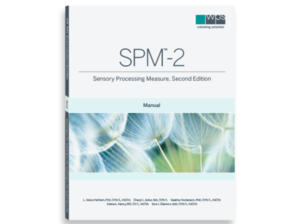The Original SPM School Kit includes:
• Manual
• Main Classroom Auto Score Forms(25)
• School Environments Form CD
Original Edition
(SPM-2) Sensory Processing Measure 2nd Edition
Home Form: Cheryl Ecker / L. Diane Parham
Main Classroom/School/ Environments Forms:Heather M. Kuhaneck / Diana A. Henry/ Tara J. Glennon
With the Sensory Processing Measure (SPM), you can now get a complete picture of children's sensory functioning at home, at school, and in the community. Recognizing that sensory processing problems often manifest differently in different environments, this set of three integrated rating scales assesses sensory processing, praxis, and social participation in elementary school children. The assessment's unique multi environment approach lets you see, for example, why a child who functions well in a highly structured classroom may have problems in a more relaxed setting.
Grounded in sensory integration theory, the SPM provides norm-referenced standard scores for two higher level integrative functions, praxis (planning and ideas) and social participation, and five sensory systems: visual, auditor)', tactile, proprioceptive (body awareness), and vestibular functioning (balance and motion).
What’s new in the SPM-2
The SPM-2 is a revision and update of the Sensory Processing Measure and Sensory Processing Measure–Preschool, two well-established instruments in wide use throughout the world. While the essential characteristics of the SPM and SPM-P remain unchanged, the SPM-2 revision includes the following improvements:
An expanded age range that encompasses the lifespan, from 4 months to 87 years
New and revised forms across five age levels: Infant/Toddler, Preschool, Child, Adolescent, and Adult
Updated norms based on a new, nationally representative standardization sample
Ability to compare sensory integration and processing function between individuals
New clinical validity studies, including sensory processing disorders, autism spectrum disorders, speech–language pathologies, intellectual and developmental disorders, attention-deficit/hyperactivity disorder, and other mental health disorders
Updated SPM-2 Quick Tips now included in every Preschool and Child kit
Ages: 4 months - 87 years



